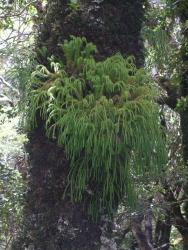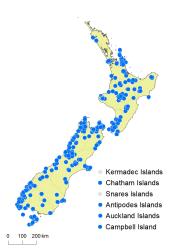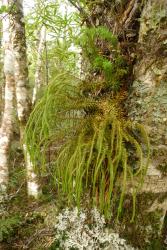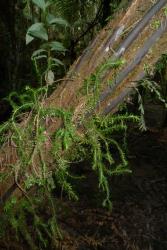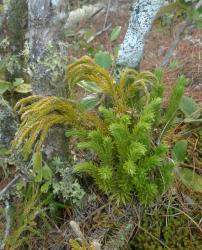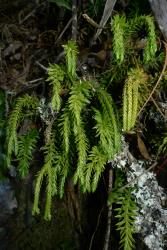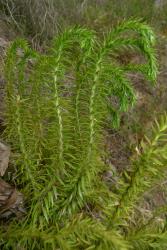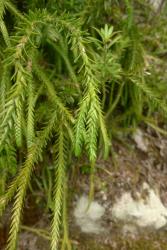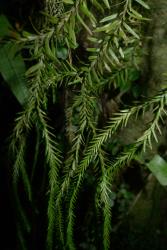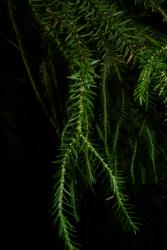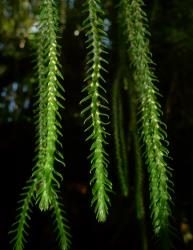- ≡ Lycopodium varium R.Br., Prodr. Fl. Nov. Holland. 165 (1810) – as varium α umbrosum
- ≡ Huperzia varia (R.Br.) Trevis., Atti Soc. Ital. Sci. Nat. 17: 247 (1874)
- ≡ Urostachys varius (R.Br.) Herter ex Nessel, Bärlappgewächse 192 (1939)
- = Lycopodium varium var. alpinum R.Br., Prodr. Fl. Nov. Holland. 165 (1810)
- = Lycopodium pachystachyum Desv. ex Poiret, Encycl. Suppl. 3, 544 (1814)
- = Lycopodium varium var. gracile Kirk, Trans. & Proc. New Zealand Inst. 16: 377, t. 29 (1884)
- ≡ Lycopodium billardierei var. gracile (Kirk) Cheeseman, Man. New Zealand Fl. 1036 (1906)
- ≡ Urostachys saturnii Herter, Index Lycopod. 80 (1949) nom. nov. pro Lycopodium varium var. gracile Kirk 1884
- = Lycopodium varium var. polaris Kirk, Trans. & Proc. New Zealand Inst. 16: 376 (1884)
- = Lycopodium novozealandicum Colenso, Trans. & Proc. New Zealand Inst. 19: 275 (1887) – as novae-zealandicum
- ≡ Huperzia novozealandica (Colenso) Holub, Folia Geobot. Phytotax. 20: 75 (1985) – as novae-zelandiae
- = Urostachys helmii Nessel, Repert. Spec. Nov. Regni Veg. 36: 186 (1934)
- ≡ Huperzia helmii (Nessel) Holub, Folia Geobot. Phytotax. 20: 73 (1985)
- = Urostachys varius var. polaris Herter ex Nessel, Revista Sudamer. Bot. 6: 376 (1940) nom. illeg., non Lycopodium varium var. polaris Kirk 1884
- ≡ Urostachys polaris (Herter ex Nessel) Herter, Index Lycopod. 76 (1949)
- ≡ Huperzia polaris (Herter ex Nessel) Holub, Folia Geobot. Phytotax. 20: 76 (1985)
Horizontal stems absent. Aerial stems erect or decumbent or pendent, branching dichotomously 1–7 times or rarely unbranched, 70– c. 1000 mm long, 12–31 mm wide (including leaves) at widest point, 6–18 mm wide near the junction with the strobili. Sterile leaves monomorphic, spirally arranged, decreasing in size towards the apex, spreading proximally and distally, linear or narrowly elliptic, apices acute to obtuse, margins entire and sometimes thickened, bases adnate, dull green; longest leaves 10–19 mm long, 1–3 mm wide; shortest leaves 4.5–10 mm long, 0.8–2.6 mm wide. Transition from sterile leaves to sporophylls gradual. Sporophylls appressed or spreading when young, spreading at maturity, ovate to narrowly ovate, apices acute to obtuse, keeled or not on back, margins entire, bases adnate, 2.5–11 mm long, 0.8–2.2 mm wide, green, aggregated into distinct or indistinct strobili. Strobili solitary or paired at end of sterile branches, each strobilus undivided or divided dichotomously 1–3 times, erect or curled downwards or pendent, green when young, yellow or green at maturity, 10–350 mm long, 3–17 mm wide, not angled to strongly 4-angled or rarely slightly bilaterally flattened.
As its name suggests, Phlegmariurus varius is a variable species that either grows erect on the ground and on rock outcrops, or is a pendent epiphytic species. The stem divides dichotomously into stems of equal thickness and produces a basal tuft of roots. The leaves are similar to the sporophylls and grade imperceptibly into strobili that are either rather poorly distinguished and sometimes slightly bilaterally flattened, or clearly defined and 4-angled at their distal ends but poorly distinguished at their proximal ends. In terrestrial plants, the strobili are often curled downwards towards the ground. By contrast, the strobili of P. billardierei are well defined and characteristically 4-angled throughout. The longest sporophylls in P. varius are generally longer than in P. billardierei (2.5–11 mm, cf. 1.5–3 mm long), and the strobili are wider at their widest point (3–17 mm, cf. 1.5–3 mm wide). The stem (including the leaves) is generally much wider just before the junction with the strobili than in P. billardierei (6–18 mm, cf. 1.5–8 mm wide).
North Island: Northland, Auckland, Volcanic Plateau, Gisborne, Taranaki, Southern North Island.
South Island: Western Nelson, Sounds-Nelson, Marlborough, Westland, Canterbury, Otago, Southland, Fiordland.
Chatham Islands, Stewart Island, Antipodes Island, Auckland Islands, Campbell Island.
Altitudinal range: 0–1500 m.
Phlegmariurus varius occurs in lowland to montane and subalpine areas of the North Island, from Great Barrier Island south, with outlying populations in the Waipoua and Warawara Forests. It mostly grows above 300 m, reaching nearly 1300 m on Mt Hikurangi and Maungapohatu, but is found in a few localities down to near sea level. In the South Island it occurs in lowland, montane and subalpine regions throughout, ranging from near sea level, up to 1500 m on Mt Starveall, Nelson. It extends to the Chatham Islands, Stewart Island and all the subantarctic islands except the Snares.
Also Australia (Queensland, New South Wales, Victoria, Tasmania) and Lord Howe Island.
Terrestrial forms of Phlegmariurus varius occur on the ground, on banks, on rock outcrops and rock faces, in rock crevices, in scrub or tussock, on boggy ground, or on fallen logs. The species also occurs as an epiphyte in podocarp, broadleaved and beech forest, or under mature mānuka. It has been recorded growing epiphytically on Cyathea medullaris, C. smithii, Dicksonia fibrosa, D. squarrosa, Elaeocarpus sp., Fuchsia excorticata, Griselinia littoralis, Metrosideros umbellata, Olearia colensoi, Prumnopitys taxifolia, Weinmannia racemosa, Vitex lucens, species of Nothofagaceae, and hanging from clumps of Astelia. It is unlike P. billardierei in occurring quite frequently on tree fern trunks.
Phlegmariurus aff. varius (a) (WAIK 7743; “tree fern”) was given a conservation status of Data Deficient by de Lange et al. (2018), but this form is included here within the range of diversity of P. varius.
2n = 256 (Murray & de Lange 2013 – as Huperzia varia). The voucher specimen (AK 303460) is sterile and could be either Phlegmariurus varius or P. billardierei.
Lycopodium varium was described by Brown (1810) from specimens he collected in Tasmania. The species included two infraspecific taxa denoted as α umbrosum and β alpinum, now var. umbrosum and var. alpinum, respectively. Brown did not mention the autonym var. varium, but this was automatically created with the valid publication of the two infraspecific taxa, and is taken as the α epithet (see Mabberley & Moore, in press). The epithet α umbrosum is superfluous and therefore illegitimate.
Brown did not identify a holotype for L. varium, but Chinnock (1998) designated R. Brown Iter Austral. 124 from Table Mountain (BM 001038064) as the lectotype. However this is labelled “β alpinum” and refers to L. varium var. alpinum (see Mabberley & Moore, in press). The lectotype for L. varium is Robert Brown Iter Austral. 123 (BM 001079913), cited in error by Chinnock as 124.
The name Lycopodium mirabile, based on a collection by Labillardière from Australia, was published by Willdenow (1810) two months before Brown’s L. varium. Strict application of the Code requires replacement of the well-known name L. varium Brown by L. mirabile (Willd.). However, Field & Brownsey (2019) proposed conservation of L. mirabile with a conserved type so that its use is maintained for an Asian species to which it has consistently been applied, and the basionym L. varium is retained for the Australasian species.
The long-overlooked name Lycopodium pachystachyum Desv. is a synonym of P. varius based on an Australian type, whereas Kirk’s L. varium var. polaris and var. gracile, Nessel’s Urostachys helmii, and Colenso’s Lycopodium novae-zealandicum are all based on New Zealand types. The latter name, which was used by Allan (1961), is an orthographic error that must be corrected to L. novozealandicum (Webb & Edgar 1999). The number of synonyms for Phlegmariurus varius is a reflection of the morphological variation in the species.
Perrie et al. (2020) segregated Phlegmariurus billardierei from P. varius using morphological and genetic evidence. The two species are sympatric in New Zealand. Perrie et al. (2020) found no morphological or genetic evidence to further sub-divide P. varius despite its morphological variability.



